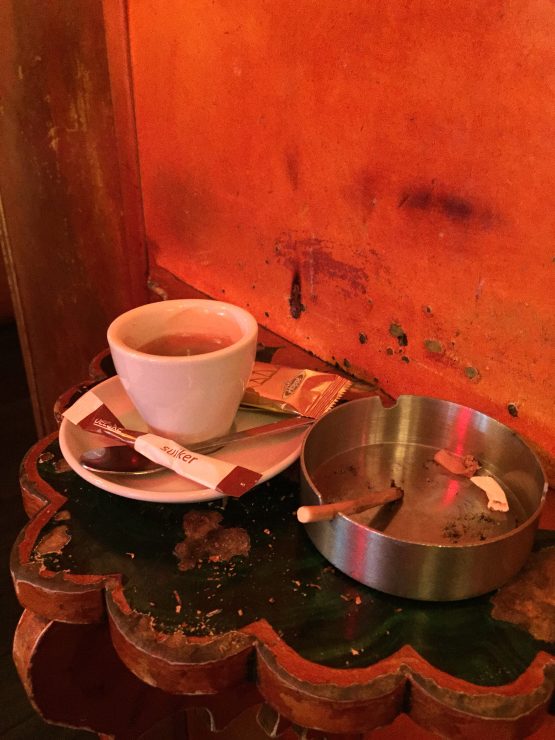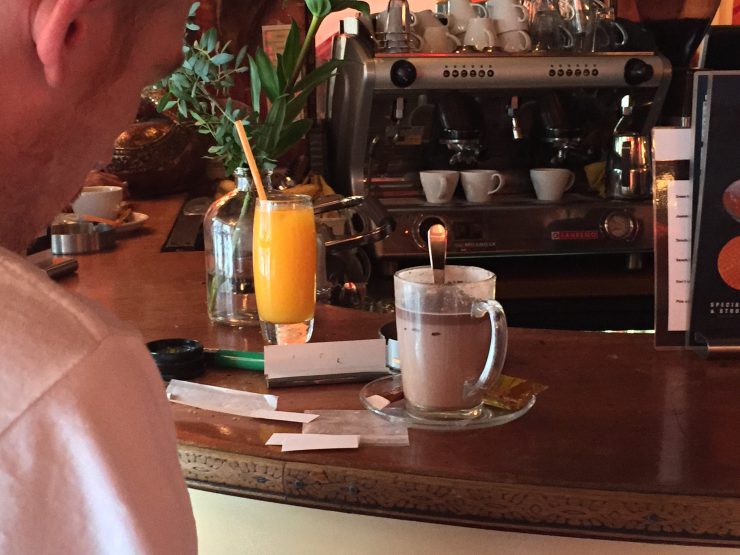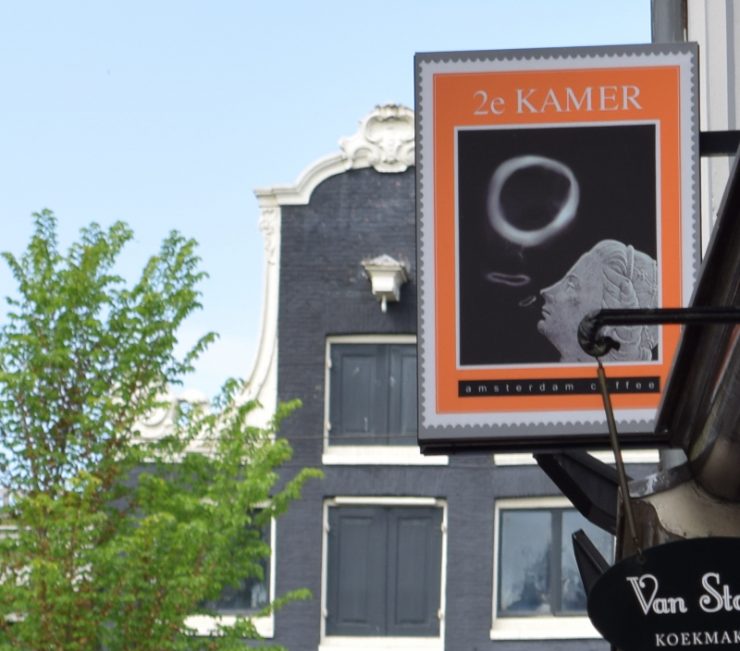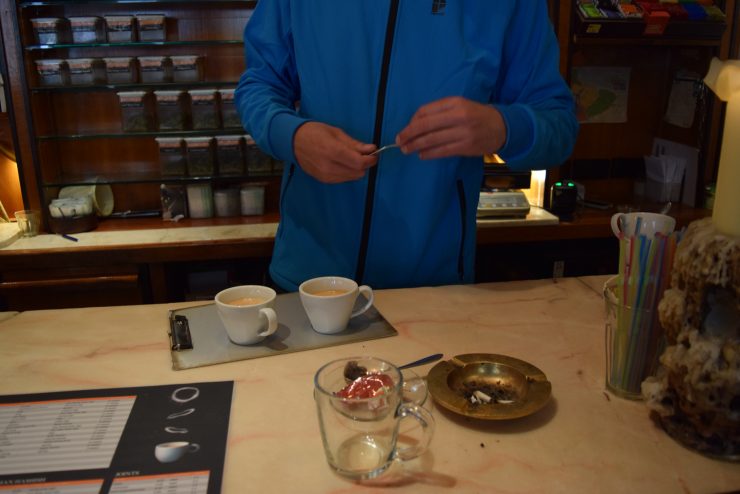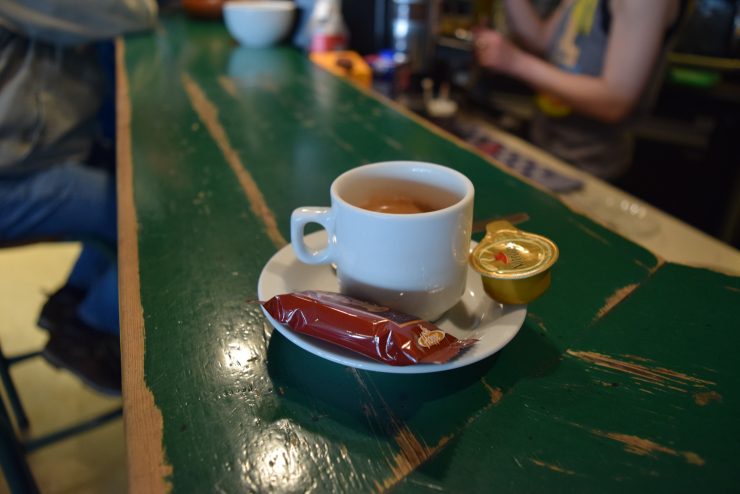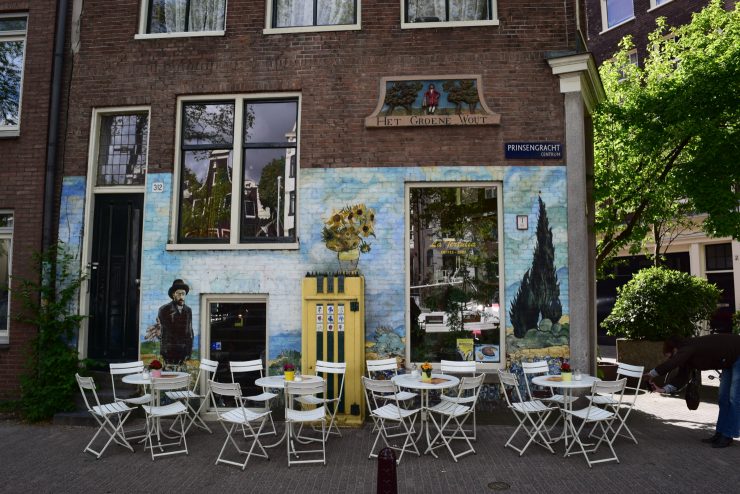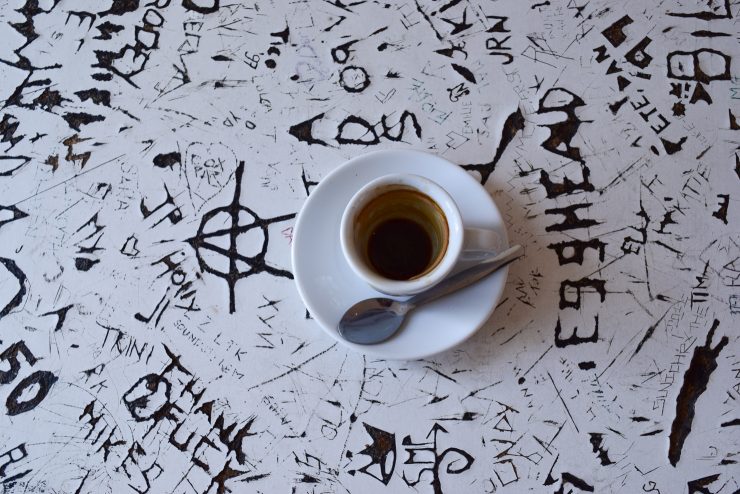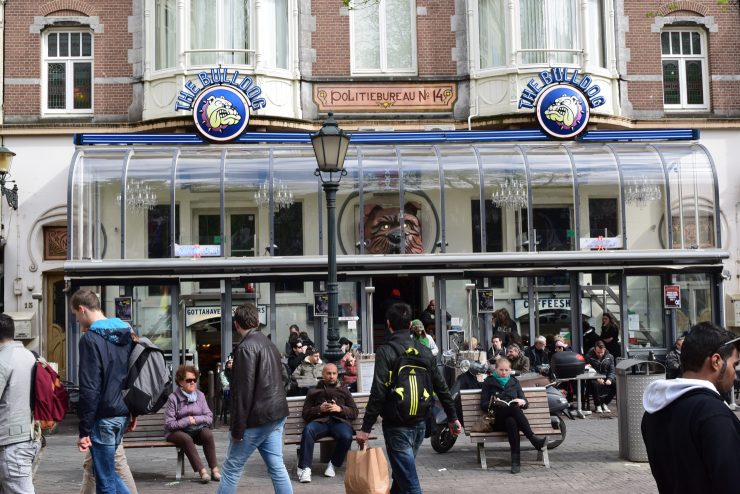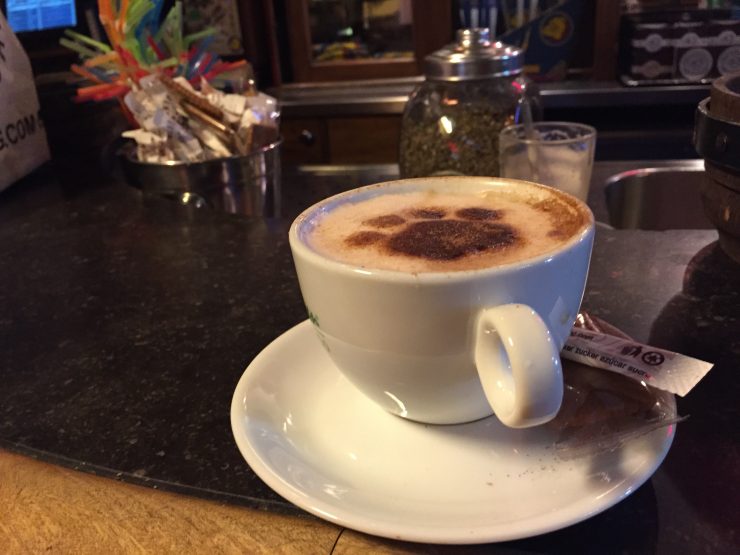The assignment was self-imposed and mandatory: I’d lived in Amsterdam for over a decade but could not say why a Dutch venue that sells cannabis is called a “coffeeshop”. Even the phrase was a mystery: two English words, Germanically smushed together and nominally failing to even hint at the menu’s most coveted items. I could not remember ever enjoying coffee at one of these places. Does anyone even drink coffee at these places?
A smoker I am not. Prufrock I am not. I have not measured out my expatriate life in coffee spoons, much less in mini press-seal bags. But past writing assignments and tag-along sessions provided sufficient first-hand experience to maintain that Amsterdam’s coffeeshops didn’t really do right by my own personally preferred psychoactive drug. (That would be caffeine.)
It was–yes–high time to unravel the mystery. This is a coffee-focused tour of Amsterdam’s coffeeshops.
Barney’s Lounge
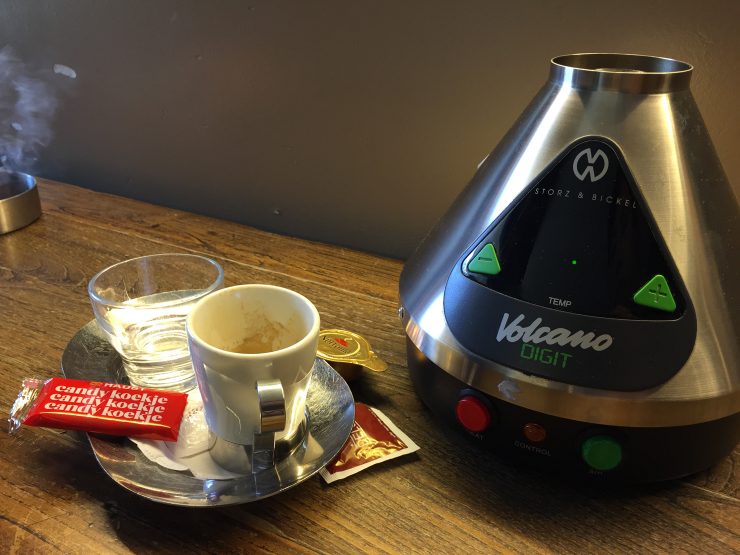
I began at Barney’s Lounge in the heart of Amsterdam’s canal ring, a UNESCO World Heritage site mere steps from the backdrop of a recent Anthropologie catalog spread. If a knee-length striped cardigan can simultaneously evoke Old World warmth and cool urban freedom, why can’t a coffeeshop deliver old-school bakedness and the gentle lift of delicious, contemporary coffee? The Lounge, after all, is the classy outpost of the three-ring Barney’s enterprise scattered across town, including a Cannabis Cup-winning coffeeshop and a smoker-friendly breakfast bar.
Machine: Gaggia, two-group
Coffee: Intenso Forte Blend; 80% Robusta, 20% Arabica
Although delivered, literally, on a silver platter, the espresso was acerbic. I well understood why it came with two sugars, a capsule of evaporated milk, and, in the Dutch tradition, a small cookie. Even the heights regularly reached on the nearby Volcano Vaporizer could not compete with the bitterness that climbed the back of my mouth. A harsh toke.
Barney’s Lounge is located at Reguliersgracht 27, Amsterdam.
Dampkring
Leaving the canals behind, I headed into the city’s shopping district for Dampkring. The blood-orange-glowing den played DJ Shadow, and its name seemed fitting—dampkring is a double entendre in Dutch, meaning “atmosphere” and “smoke circle.”A scene from Ocean’s Twelve was filmed here, and for years after the cafe showed the film on loop, a practice that has thankfully ceased. Still, I wondered, how might the Nespresso-sipping specter of George Clooney influence my order?
Machine: Sanremo, two-group
Coffee: “I don’t know,” said a harried barwoman who took no interest in helping me learn the provenance of their coffee.
Anyway, drinking from the same white demitasse as Brad Pitt did nothing to distract from some bitter gulps. Neither did the famous-on-Twitter cafe cat, #odkbowie, or the lush tiger lilies, atmospheric though they were.
Dampkring is located at Handboogstraat 29, Amsterdam.
De Tweede Kamer
Though one of the smallest coffeeshops around, De Tweede Kamer feels important, even lofty. That perception may have something to do with its name, which translates to “the second chamber”, a reference to the Netherlands House of Representatives. Studying the storefront logo that features a profile of the old queen, I noticed that under Juliana’s head, it simply reads “Amsterdam coffee”. Did the drop of “shop” imply that the beverage had some kind of elevated status here?
Machine: Sanremo, single-group
Coffee: Their “own blend” of a Brazilian Arabica is how 22-year veteran dealer/barista Hans van Brunschot described it. But spill the beans about the specific roaster brand, he did not.
This was the easiest espresso I’d had so far that day: lighter, fruitier, with hints of chocolate. But was it a cafe royal? Well, nee.
De Tweede Kamer is located at Heisteeg 6, Amsterdam.
The Bluebird
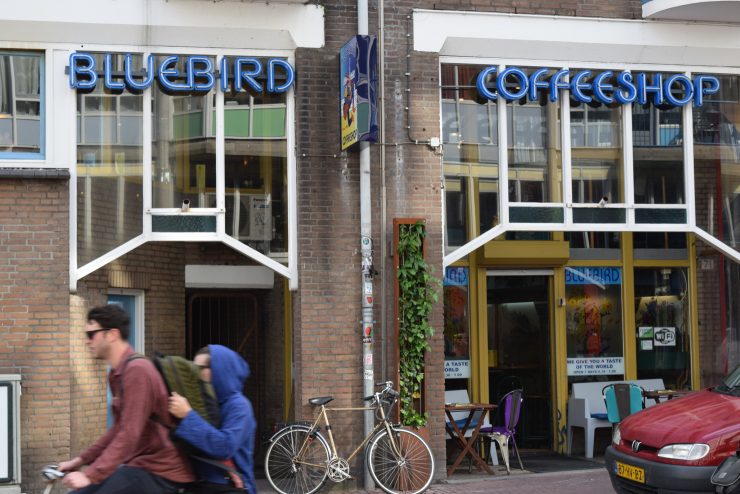
After visiting several other venues not worth wasting word count for, I seriously doubted that coffeeshops had gotten the memo other tourist-trodden spots in Amsterdam had clearly read and actioned. Metropolitans with moderate taste, me included, appreciate specialty coffee. Perhaps coffeeshop coffee was meant to stay purely functional, relegated to that Robusta smack in a stoner’s face. It feels like a missed opportunity.
Then, in the azure confines of a coffeeshop across the street from Rembrandt’s old digs, I discovered otherwise. Upstairs at The Bluebird, the barwoman was quick to relay that their beans come from Simon Lévelt, a Dutch company that began roasting in Amsterdam in 1817. Downstairs, I spoke with Jawi Heij, who nearly a year ago was hired by the two owners to address what they all agreed was a coffee crisis. “It was going around,” said Heij. “It was in newspapers all around the world, how bad the coffee and the service was.” I slurped up the validation. Heij’s top priority, he explained, has been giving all staff a barista training, something he himself benefitted from during a 15-year career at Amsterdam’s Hilton Hotel (of John and Yoko bed-in fame).
Machine: Gaggia, 2-group
Coffee: Simon Lévelt Espresso Beneficio; 95% Arabica, 5% Robusta; South America
So finally, I had a satisfying espresso. Its flavor was mild but enduring, sharp and round at the same time. Not bad for a two-century-old roaster.
The Bluebird is located at Sint Antoniesbreestraat 71, Amsterdam.
La Tertulia
La Tertulia has always had a uniquely un-coffeeshop-like airiness about it. The breezes blow off the city’s longest canal. Carbon dioxide-hungry plants abound. Light streams through big windows—and it was on one of them that, from the outside, I saw the small sign: “La Tertulia proudly serves Bocca coffee.” This was interesting. Bocca, which began roasting in 2001 in an Amsterdam garage just a few blocks northward, is fast becoming the Netherlands’ favorite specialty roaster, and the brand has been represented at international coffee competitions by Dutch baristas. The company has some scale, but remains indie enough for Third Wave cafes to showcase it.
The elder of the mother-daughter duo, who own the coffeeshop, told me they had been using these beans for “three or four years.” Forgiving her imprecision, I asked how was it that they decided on that particular brand. I wanted a moving story: say, about the communitas of cannabis and coffee and its leveling effect on humanity. “Looking on the internet,” she replied.
Machine: La Pavoni, single-group
Coffee: Bocca Full Blend; 100% Arabica; Brazil and Ethiopia
Despite its touch of sourness, this espresso’s consistency and gentle creep of a caffeine hit was like no other coffee on this tour. Even if La Tertulia’s purveyors didn’t seem as proud as their window ad suggested, this was, finally, coffee I was enjoying at a coffeeshop.
La Tertulia is located at Prinsengracht 312, Amsterdam.
Bulldog Havri
Soon I had had enough coffeeshops. And yet, on a very last visit, I found myself at Amsterdam’s most famous coffeeshop, one that, insofar as my THC-wary brain recollected, I had never before stepped foot in. That Britney Spears, Mike Tyson, and various other paparazzi objectives had been spotted at Bulldog Havri was not reason enough to sample their coffee.
After an email exchange with Bulldog’s accommodating marketing department—to inquire about The Bulldog’s Iced Coffee Amsterdam Blend, a coffeeshop novelty I’d seen online—I found myself sitting at the bar with marketing rep Linda Versteeg. The iced coffee, I learned, was made from beans by Carmen, the Dutch brand that also supplies The Bulldog with their regular in-house beans, a two-year-old organic, Fair Trade mostly Ethiopian blend of 100% Arabica.
Treated to an admittedly tasty espresso, chased by a cappuccino with a less palatable chocolate paw stenciled on the foam, I took the opportunity to work on the other part of my assignment. Why use the word “coffeeshop”, I asked Versteeg. “That comes from Henk de Vries,” she said, referring to her boss, The Bulldog’s founder. His multiple-property empire began in 1975 when, as the story goes, De Vries converted his father’s sex store into the flagship coffeeshop now in the Red Light District. But why then “coffee,” when that is hardly what visitors come for?
Later, through an e-mail fielded by Versteeg, De Vries answered my question. He wrote: “I wanted to capture the coffeehouse feeling, keep the atmosphere of a living room. At the same time, I wanted to have an international character to the place, that’s how the term ‘coffeeshop’ [in English] was born.”
Etymologists can debate whether De Vries deserves the coinage credit, but his story does not contradict what other social historians have to say on the matter. Using “coffee” to describe their businesses, De Vries and his cohorts emphasize what they do not do—sell hard alcohol or hard drugs. Rather, theirs are places where in one hand you may hold a burning cone and, in the other, a steaming cup.
As the Bulldog barwoman said to me, “Coffee and a smoke really goes together.” Then she gushed about the popularity of the Dutch chocolate drink Chocomel, especially when heated and topped with whipped cream. At that point, over-caffeinated and raising my voice over the speakers’ blare (“Dust in the Wind” by Kansas), I started pushing for anecdotes about what the celebs like to order at Bulldog. None readily came, until finally, she threw me a bone: “I remember Joss Stone coming in a zillion times—really for the chocolate.”
Bulldog Havri is located at Leidseplein 17, Amsterdam.
Karina Hof is a freelance journalist based in Amsterdam. Read more Karina Hof on Sprudge.
The post You Can Smoke Weed In Amsterdam Coffee Shops, But Is The Coffee Legit? appeared first on Sprudge.


